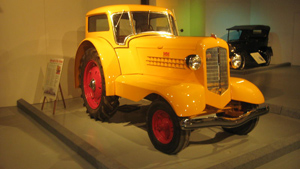
Since that time, he’s acquired more than 230 other tractors.
Many of those former working vehicles of the fields are on display at Keystone Tractor Works, a new antique tractor museum located in Colonial Heights.
“We’ve been attempting to open the museum for a few years,” Jones said.
In November 2009, the former Benjamin-Moore paint factory in Colonial Heights became available. That’s when Jones says he purchased the building. Since July he and his business partners, including Museum Curator Alan “Bones” Stone, have been hard at work making sure the building would be ready.
“In the past week I’ve walked more than 50 miles just in this building,” Stone said. He explained that his phone has a built-in pedometer and he’s walked the equivalent of a trip to Richmond and back just inside the building going back and forth supervising companies making final touches to the building and getting displays ready.
Jones said that part of building the collection involved buying several smaller collections. He’s also attended auctions and looked into private sales of tractors.
“Once you get to that point, guys start contacting you to see if you want to buy their tractor,” Stone said.
The oldest tractor in the collection is a Waterloo Boy from 1915. Jones said that around that time the company was bought by a larger, more famous company that survives to this day – John Deere.
The collection spans from 1915 to approximately 1960. “That’s when John Deere quit making the two-cylinder tractors,” Jones said.
The brands represented in the collection include John Deere, International Harvester, Case, Minneapolis Moline among others. There are also several “orphan brands” represented in the collection. Jones explained that the orphan brands include tractors that were low production numbers, brands that only were around for a year or in some cases tractors that were built by one company and renamed several different ways.
One such example includes the same Chrysler engine on three different tractor bodies, with three different brands.
“You’d even take it to the Chrysler dealership to have it serviced,” Stone said.
One of the most valuable tractors in the museum is a Minneapolis-Moline that was built for the 1938 model year. The tractor included a cab and second seat.
“The idea was that you’d use it for plowing the fields through the week and then drive it to church on Sunday,” Jones said. Only 150 of the model were made. Jones said that 50 later had the cab removed because the company wasn’t able to sell them. Ten of the 150 were convertible models. “All told there are only about 30 in existence still today I’ve heard.”
Restoring the tractors has for the most part been without too much difficulty. Jones said each tractor is typically taken apart completely, sanded and carefully repainted and put back together again. While some have been more challenging than others, it’s been mostly trouble free – even when finding parts. The hardest part has been finding tires for some of the tractors.
___
Information from: The Progress-Index,
http://www.progress-index.com
Copyright 2010 Associated Press. All rights reserved. This material may not be published, broadcast, rewritten, or redistributed.
AP-ES-10-18-10 0003EDT

